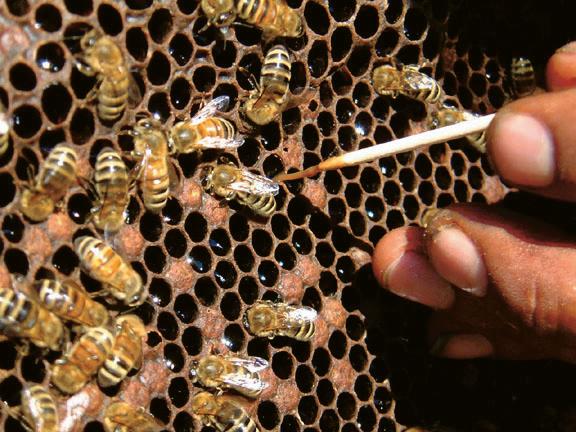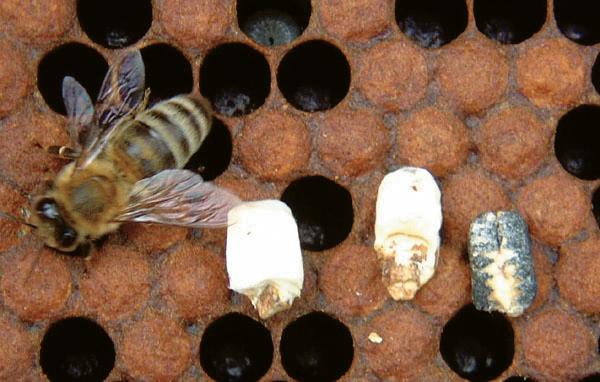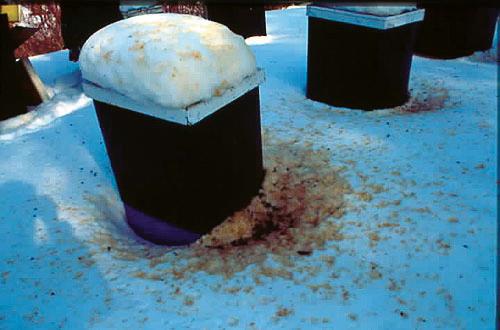Beekeeping Practices

The most essential beekeeping practice is to make sure all colonies have large pollen and nectar stores at all times. Knowing when and how much to feed bees is an art and comes with experience. In general, the more proactive beekeepers are about providing supplemental feedings, the better. Good nutrition is critical for keeping healthy bees.
Another essential practice to prevent diseases is to replace all combs within the brood nest of every honey bee colony every three to five years. Traditionally, beekeepers do not replace combs because it is costly to replace the foundation, and it is energetically costly for the bees to secrete wax to build a new comb. Some beekeepers have beeswax combs that are over 30 years old.

Old combs in the brood nest can harbor disease spores from at least three honey bee diseases: American foulbrood (figure 2.7) caused by Paenibacillus larvae, chalkbrood (figure 2.8) caused by Ascosphaera apis, and nosema caused by Nosema apis (Figure 2.9) and N. ceranae. These spores may remain viable in combs indefinitely. Many beekeepers have had the unfortunate experience of purchasing used equipment from a beekeeper, or hiving a new colony of bees in used equipment, and having the bees die from spores lurking in the combs.

In addition, beeswax absorbs some pesticides, depending on the properties of the particular compound. The accumulation of pesticides in beeswax most likely has negative effects on the health of bees.
Sampling
Sampling colonies for diseases and mites may be the most important thing a beekeeper can do. A little time spent on sampling could make or break a beekeeping operation. Colonies should be routinely sampled for Varroa mites and Nosema. Sampling techniques can be found in beekeeping trade journals. Sampling helps beekeepers make educated management and treatment decisions to control diseases and mites. If beekeepers assume that bees are healthy just because they look good, they may suddenly lose them three months later. If they assume that bees are diseased or infested with mites and they are treated without sampling, beekeepers may be spending a lot of time and money adding unnecessary and possibly harmful chemicals to colonies. Unnecessary treatments risk the contamination of wax and honey and lead to the eventual development of resistance to the treatment by the disease or mite. The old adage, “Better be safe than sorry” does not hold for unnecessary treatments!
Bee Self-Defense!
The wisest strategy for beekeepers is to keep bees that can defend themselves against diseases and mites. Honey bees can evolve resistance to pathogens and pests naturally over time, or they can be selectively bred for resistance. Keeping bees that can defend themselves allows beekeepers to reduce their reliance on chemical controls, which is the best solution in the long run.
One example of bees that have evolved natural resistance against Varroa mites is the subspecies of honey bees derived from Africa that were imported to Brazil in 1956. As they spread through South and Central America, Mexico, and the southern US, they became known as Africanized honey bees. Unfortunately, most colonies of Africanized bees have a personality that most beekeepers don’t like: they are highly defensive. They are notorious for their ability to stage an impressive stinging attack when their nest is disturbed, making them impossible to keep in public areas and on farms where there are animals. They are not amenable to being transported en masse by truck for pollination, and so even if they are resistant to Varroa mites, they are not a viable alternative to our gentle European-derived honey bees. Could we selectively breed for a more gentle, Africanized bee that retains its resistance to mites? It’s definitely worth a try.
Another bee that has evolved some natural resistance to Varroa mites is a line of bees derived from far eastern Russia, in the Primorsky Territory. These bees had been living with Varroa for many years. The USDA (Bee Research Lab in Baton Rouge, Louisiana) imported some of these bees in 1996. Some stock improvement has taken place in the US through field trials of the bees with commercial beekeepers, and Russian bees are now available commercially throughout the US. Many beekeepers like working with these bees and find they can reduce or eliminate the need for chemical treatments for both Varroa and tracheal mites, particularly when mite re-infestation from surrounding colonies (horizontal transmission) is not too high.
Bees already present in the US can be selectively bred for resistance. Two lines of bees have been bred and are commercially available: the MN Hygienic line, bred at the University of Minnesota, and the VSH (Varroa Sensitive Hygiene) line, bred at the USDA Bee Lab in Baton Rouge. Both lines are able to detect worker pupae that are infested with Varroa mites. Adult bees detect and remove the infested pupae from the cells and throw them out of the nest. The bees tend to detect that a pupa is infested with a mite after the mite has initiated oviposition (egglaying). When the bees remove an infested pupa out of its cell, the reproductive cycle of the mite is interrupted, and any mite offspring are killed in the removal process. The net result is some pupae are sacrificed but the level of Varroa mites in the colony is reduced. The VSH line seems to specialize in detecting Varroa mites in worker pupae and removing the infested pupae. The MN Hygienic line has a more generalized response; in addition to removing mite-infested pupae, these bees also detect larvae and prepupae that are infected with American foulbrood and chalkbrood. The interesting thing is that hygienic bees detect diseased brood before the pathogen in the brood has reached the infectious stage. The bees remove the pathogen-infected brood from the cell and from the nest before it is contagious. Therefore, they do not risk transmitting the pathogen through the nest, and can curtail the progress of the disease through the colony entirely.
Any race or line of bees can be bred for hygienic behavior. For specific instructions see www.extension.umn.edu/honeybees. A beekeeper can get a head start on selecting for hygienic behavior simply by rearing queens from colonies that never show symptoms of chalkbrood.
In any breeding program it is absolutely essential to begin with a line of bees that produces honey, survives winter well, is gentle, and displays all the characteristics desired by the beekeeper. Do not select colonies for a single resistance trait without first evaluating their performance in other areas. The result will be colonies that express hygienic behavior or VSH, for example, but don’t necessarily produce honey or survive the winter.
Here is an obvious question: If hygienic behavior is so good, why don’t all honey bees in the US demonstrate this behavior? Why haven’t they evolved this behavior on their own, in response to the challenge from diseases and Varroa? The answer lies with the queen-rearing industry in the US. The queen-rearing industry is a subsection of the beekeeping industry that rears and sells mated queen bees to other beekeepers nationwide. The genetics of our honey bee stocks in the US are controlled primarily by queen producers. The feral escapee colonies are basically non-existent in the US now due to Varroa, and the effects of natural selection are overpowered by man-assisted selection. Unfortunately, many queen producers still propagate and sell susceptible queens that cannot resist diseases and mites and so require chemical treatment.
The solution is for all beekeepers that raise queen bees, either for their own use or for sale, to propagate resistance traits. It is easy to select bees for hygienic behavior; that would be a good starting point. There are many fine lines of bees in the US, and it would be easy to select for hygienic behavior from among them. We would not lose genetic diversity this way. The drones (male bees) produced by colonies that demonstrate resistance would mate with queens bred for resistance, and it would be possible for all bees from many different lines and subspecies to express hygienic behavior.
One solution may be for the honey bee industry to implement stock certification programs. It is possible to certify that a particular line of bees is Russian, or displays hygienic or VSH behavior. A queen producer could command a good price for a certified queen. It is time to make this happen.
